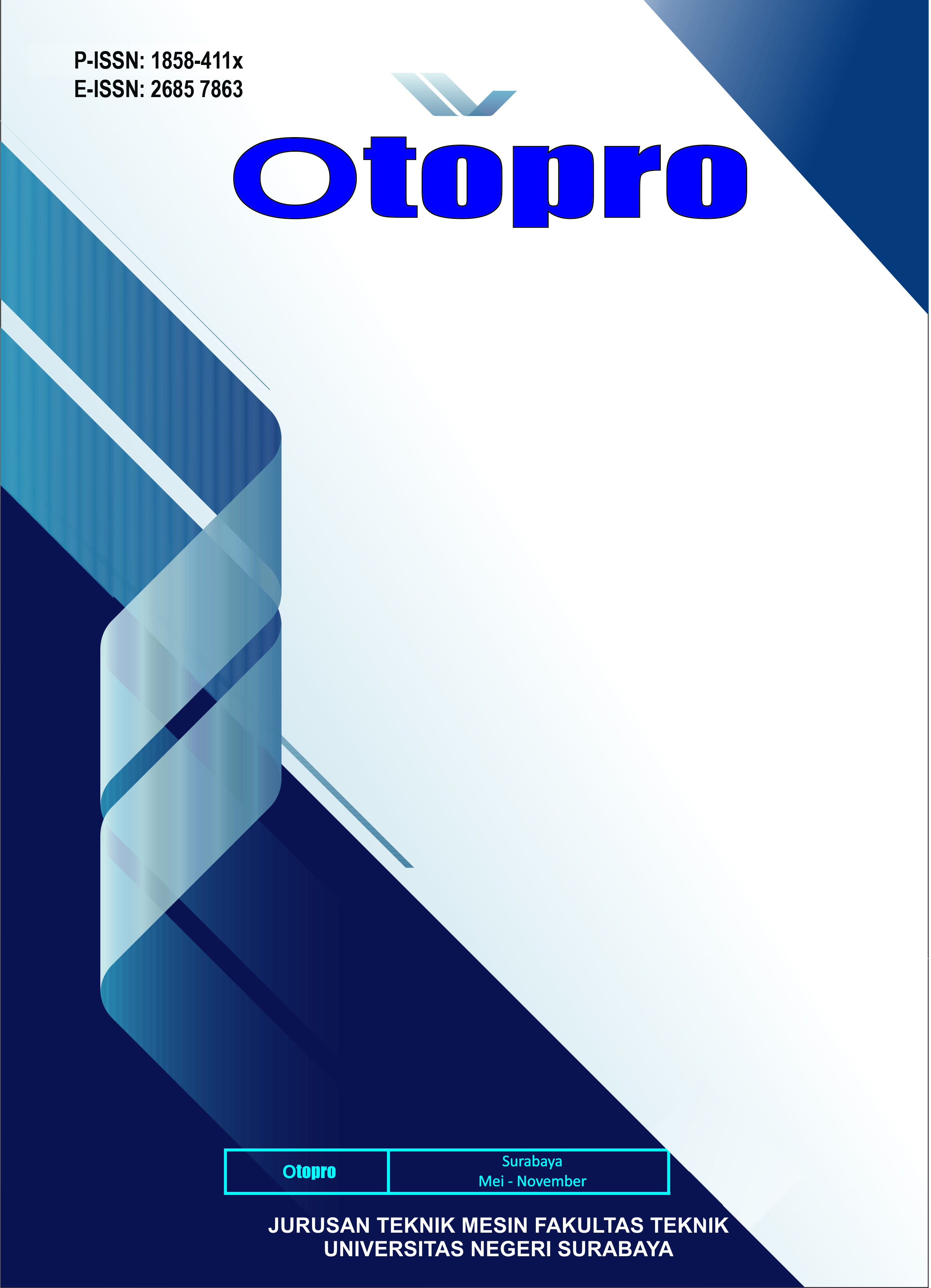SIMULASI NUMERIK PENGARUH VARIASI RASIO PANJANG LEADING EDGE TERHADAP KARAKTERISTIK AERODINAMIKA PADA MOBIL PICK UP
DOI:
https://doi.org/10.26740/otopro.v15n2.p45-53Keywords:
Numerical Simulation, Leading Edge, Aerodynamic Characteristics, Pick UpAbstract
The aerodynamic style influences fuel consumption due to drag and the stability of the vehicle speed due to the force lift. Varying the geometry of the leading edge is estimated to have an effect on aerodynamics. This study uses a car pickup model with dimensions like the actual size. Geometry Leading Edge can be modified so that in the variation of the ratio of length leading edge of the vehicle's overall length ( ): ; and . The research method used is a 2-D numerical simulation underconditions steady and unsteady using software ANSYS FLUENT 2019 R3. The mesh using Hybrid model, its triangular and rectangular shape. The viscous model used by k-epsilon Realizable with variation Reynolds Number 7.15 x 104; 2.6 x 106; 3.26 x 106 and 3.91 x 106. The result data analyzed are coefficient lift (CL), coefficient drag (CD), velocity contour, velocity streamline, and pressure contour. From the simulation results, varying ratio of the length of leading edge can affect aerodynamic characteristics of the car. The greater leading edge ratio can delay separation above the car. In addition, the momentum deficit behind the vehicle is also getting smaller. Variation of the length ratio of leading edge is the best variation, having a coefficient drag (CD) of 0.72 with a percentage decrease of 4% and a coefficient lift (CL) of 0.07 with a reduction percentage of 36.36% of the standard variation. CD and CL values go down making fuel consumption more efficient and the car more stable.
References
Barnard, R. H. (2009). Road Vehicle Aerodyamic Design. Third Edition. Hertfordshire: MechAero Publishing.
Fox, Robert W. and Mc. Donald, Alan T. 2003. Introduction to Fluid Mechanics 6th Edition. New York: John Wiley & Sons, Inc.
Hucho, Wolf-Heinrich, and Sovran, G. 1993. Aerodynamics of Road Vehicles. Annual Review of Fluid Mechanics. Vol. 25(1), pp485-537.
Katz, Joseph. 2006. Aerodynamics of Race Car. San Diego: Department of Aerospace Engineering, San Diego State University.
Mustafa, Ahmad Endra. 2018. Simulasi Numerik Variasi Leading Edge Terhadap Karakteristik Aerodinamika Bodi Bus. Jurnal Pendidikan Teknik Mesin. Volume 07 Nomor 03 Tahun 2018. 109-116.
Nevers, Noel de, 1991. Fluid Mechanics for Chemical Engineers. 2nd Edition. New York: Mc Graw Hill.
Surya, P. B. 2014. Pengaruh Variasi screen terhadap Intensitas Turbulensi Wind Tunnel Tipe Open Circuit Subsonic di Jurusan Teknik Mesin UNESA. Jurnal Teknik Mesin. Volume 03 Nomor 02: 29-37. Surabaya: Universitas Negeri Surabaya.
Sutantra, I Nyoman. 2010. Teknologi Otomoitif Teori dan Aplikasinya. Edisi Kedua. Surabaya: Guna Widya Press.
Tuakia, Firman. 2008. Dasar-Dasar CFD Menggunakan FLUENT. Bandung: Informatika.
Wailanduw. A. G. 2005. Studi Karakteristik Aliran Pada Kendaraan Jenis Van yang Menggunakan Side Airdams. JURNAL TEKNIKA Fakultas Teknik UNESA. Vol. 6 No. 2, Agustus 2005: 130 141.
Young, Donald F., Bruce R. Munson, Theodore H. Okiishi, Wade B. Huebsch. 2011. A Brief Introduction to Fluid Mechanics.5th Edition. New York: John Wiley & Sons, Inc.
Downloads
Published
How to Cite
Issue
Section
 Abstract views: 344
,
Abstract views: 344
, PDF Downloads: 731
PDF Downloads: 731



3.png)










